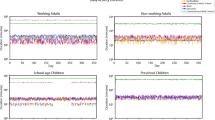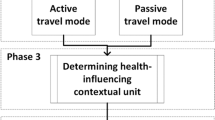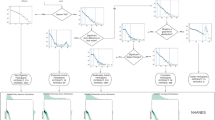Abstract
Understanding the longitudinal properties of the time spent in different locations and activities is important in characterizing human exposure to pollutants. The results of a four-season longitudinal time-activity diary study in eight working adults are presented, with the goal of improving the parameterization of human activity algorithms in EPA’s exposure modeling efforts. Despite the longitudinal, multi-season nature of the study, participant non-compliance with the protocol over time did not play a major role in data collection. The diversity (D)—a ranked intraclass correlation coefficient (ICC)— and lag-one autocorrelation (A) statistics of study participants are presented for time spent in outdoor, motor vehicle, residential, and other-indoor locations. Day-type (workday versus non-workday, and weekday versus weekend), season, temperature, and gender differences in the time spent in selected locations and activities are described, and D & A statistics are presented. The overall D and ICC values ranged from approximately 0.08–0.26, while the mean population rank A values ranged from approximately 0.19–0.36. These statistics indicate that intra-individual variability exceeds explained inter-individual variability, and low day-to-day correlations among locations. Most exposure models do not address these behavioral characteristics, and thus underestimate population exposure distributions and subsequent health risks associated with environmental exposures.
This is a preview of subscription content, access via your institution
Access options
Subscribe to this journal
Receive 6 print issues and online access
$259.00 per year
only $43.17 per issue
Buy this article
- Purchase on Springer Link
- Instant access to full article PDF
Prices may be subject to local taxes which are calculated during checkout



Similar content being viewed by others
References
Hertz-Picciotto I, Cassady D, Lee K, Bennett DH, Ritz B, Vogt R . Study of Use of Products and Exposure-Related Behaviors (SUPERB): study design, methods, and demographic characteristics of cohorts. Environ Health 2010; 9: 54.
McCurdy T, Glen G, Smith L, Lakkadi Y . The National Exposure Research Laboratory's consolidated human activity database. J Expos Anal Environ Epidemiol 2000; 10: 566–578.
Total USEPA . Risk Integrated Methodology (TRIM) Air Pollutants Exposure Model Documentation (TRIM.Expo/APEX, Version 4.3 Volume 1 Users Guide). EPA, 452/B-08-001a Research Triangle Park, NC: U.S: Environmental Protection Agency, 2008a.
Total USEPA . Risk Integrated Methodology (TRIM) Air Pollutants Exposure Model Documentation (TRIM.Expo/APEX, Version 4.3 Volume 2: Technical Support Document. (EPA, 452/B-08-001b) . Research Triangle Park, NC: US: Environmental Protection Agency, 2008b.
Rosenbaum A, Huang M . The HAPEM6 User’s Guide. Research Triangle Park. NC: U.S. Environmental Protection Agency 2007.
Zartarian V, Xue J, Glen G, Smith L, Tulve N, Tornero-Velez R . Quantifying children's aggregate (dietary and residential) exposure and dose to permethrin: application and evaluation of EPA's probabilistic SHEDS-Multimedia model. J Expos Sci Environ Epidemiol 2012; 22: 267–273.
Xue J, Zartarian V, Liu S, Geller A . Methyl Mercury Exposure from Fish Consumption in Vulnerable Racial/Ethnic Populations. Sci Tot Env 2012; 414: 373–379.
Glen G, Smith L, Isaacs K, McCurdy T, Langstaff J . A new method of longitudinal diary assembly for human exposure modeling. J Expos Sci Environ Epidemiol 2008; 18: 299–311.
Wu X, Fan Z, Ohman-Strickland P . Time-location patterns of a population living in an air pollution hotspot. J Environ Public Health [Internet] 2010, Available from http://www.hindawi.com/journals/jeph/2010/625461/.
Xue J, McCurdy T, Spengler J, Ozkaynak H . Understanding variability in time spent in selected locations for 7-12-year old children. J Expos Anal Environ Epidemiol 2004; 14: 222–233.
Johnson T . Human Activity Patterns in Cincinnati. Ohio. Palo Alto, CA: Electric Power Research Institute, 1989.
Ås D . Studies of time use: problems and prospects. Acta Sociol 1978; 21: 125–134.
Kan MY, Pudney S . Measurement error in stylised and diary data on time use. Sociol Meth 2008; 38: 101–132.
Robinson JP . How Americans Use Time. New York: Praeger Publishers, 1977.
Harvey AS . Guidelines for time use data collection. Social Indic Res 1993; 30: 197–228.
Conover WJ . Practical Nonparametric Statistics, 2nd ed. New York: John Wiley & Sons, 1980.
Shrout PE, Fleiss JL . Intraclass Correlations: Uses in Assessing Rater Reliability. Psych Bull 1979; 2: 420–428.
Giraudeau B, Mary JY . Planning a reproducibility study: how many subjects and how many replicates per subject for an expected width of the 95 per cent confidence interval of the intraclass correlation coefficient. Stat Med 2001; 20: 3205–3214.
Xue J, McCurdy T, Burke J, Bhaduri B, Liu C, Nutaro J et al. Analyses of school commuting data for exposure modeling purposes. J Expos Sci Environ Epidemiol 2010; 20: 69–78.
Graham SE, McCurdy T . Developing meaningful cohorts for human exposure models. J Expos Anal Environ Epidemiol 2004; 14: 23–43.
McCurdy T, Graham SE . Using human activity data in exposure models: analysis of discriminating factors. J Expos Anal Environ Epidemiol 2003; 13: 294–317.
Frazier EL, McCurdy T, Williams R, Linn WS, George BJ . Intra- and inter-individual variability in location data for two U.S. health-compromised elderly cohorts. J Expos Sci Environ Epidemiol 2009; 19: 580–592.
Ridley K, Olds T, Hands B, Larkin D, Parker H . Intra-individual variation in children’s physical activity patterns: implications for measurement. J Sci Med Sport 2009; 12: 568–572.
Hattis DL . Distributional analyses for children’s inhalation risk assessments. J Tox Environ Health 2008; 71: 218–226.
Hattis DL, Anderson EL . What should be the implications of uncertainty, variability, and inherent ‘biases’/’conservatism’ for risk management decision-making. Risk Anal 1999; 19: 95–107.
Glorieux I, Minnen J . How many days? A comparison of the quality of time-use data from 2-day and 7-day diaries. Inter J Time Use Res 2009; 6: 314–327.
Schwab M, McDermott A, Spengler JD . Using longitudinal data to understand children's activity patterns in an exposure context: data from the Kanawha County health study. Environ Inter 1992; 18: 173–189.
Stopher P, Greaves S . Clifford E. Multi-day household travel surveys: sampling issues. 30th Australasian Transport Research Forum 2007, 1–12.
Echols SL, MacIntosh DL, Hammerstrom KA, Ryan PB . Temporal variability of microenvironmental time budgets in Maryland. J Expos Anal Environ Epidemiol 1999; 9: 502–512.
Rodes C, Lawless P, Thornburg J, Croghan C, Vette A, Williams R . DEARS particulate matter relationships for personal, indoor, outdoor, and central site settings for a general population. Atmos Environ 2010; 4: 1386–1399.
Wu X, Bennett DH, Lee K, Cassady DL, Ritz B, Hertz-Picciotto I . Longitudinal variability of time-location/activity patterns of population at different ages: a longitudinal study in California. Environ Health [Internet]. 2011; 10: 80 Available from http://www.ehjournal.net/content/10/1/80.
Zuzanek J, Smale BJ . Life-cycle variations in across-the-week allocation of time to selected daily activities. Loisir et Société 1993; 15: 559–586.
Geyh AS, Xue J, Ozkaynak H, Spengler JD . The Harvard Southern California Chronic Ozone Exposure Study: assessing ozone exposure of grade-school-age children in two Southern California communities. Environ Health Perspect 2000; 108: 265–270.
Phillips MJ, Rodes CE, Thornburg JW, Whitmore R, Vette A, Williams R . Recruitment and Retention Strategies for Environmental Exposure Studies: Lessons from the Detroit Exposure and Aerosol Research Study. RTI Press publication No. MR-0021-1011. Research Triangle Park, NC: RTI Press. 2010, Available at http://www.rti.org/pubs/mr-0021-1011-phillips.pdf.
Stone SL, Graham S, Pekar Z, Mansfield C, Depro B, Isaacs K et al. Using EPA’s Air Quality Index (AQI) to reduce cardiovascular morbidity and mortality in older adults. American Public Health Association 140th Annual Meeting: San Francisco, Abstract 260301 2012.
Loh MM . Houseman EA, Levy JI, Spengler JD, Bennett DH. Contribution to volatile organic compound exposures from time spent in stores and restaurants and bars. J Expos Sci Environ Epidemiol 2009; 19: 660–673.
Freeman NC, Lioy PJ, Pellizzari E, Zelon H, Thomas K, Clayton A et al. Responses to the region 5 NHEXAS time/activity diary. National Human Exposure Assessment Survey. J Expos Anal Environ Epidemiol 1999; 9: 414–426.
Williams R, Suggs J, Rea A, Leovic K, Vette A, Croghan C et al. The Research Triangle Park particulate matter panel study: PM mass concentration relationships. Atmos Environ 2003; 37: 5349–5363.
Hattis D, Russ A, Goble R, Banati P, Chu M . Human interindividual variability in susceptibility to airborne particles. Risk Anal 2001; 21: 585–599.
McCurdy T . Modeling the dose profile in human exposure assessments: ozone as an example. Rev Tox: In Vivo Tox Risk Assess 1997; 1: 3–23.
Author information
Authors and Affiliations
Corresponding author
Ethics declarations
Competing interests
The U.S.Environmental Protection Agency (EPA) through its Office of Research and Development conducted the research described in this paper. It has been subjected to Agency review and approved for publication.
Competing interests
The authors declare no conflict of interest.
Rights and permissions
About this article
Cite this article
Isaacs, K., McCurdy, T., Glen, G. et al. Statistical properties of longitudinal time-activity data for use in human exposure modeling. J Expo Sci Environ Epidemiol 23, 328–336 (2013). https://doi.org/10.1038/jes.2012.94
Received:
Revised:
Accepted:
Published:
Issue Date:
DOI: https://doi.org/10.1038/jes.2012.94
Keywords
This article is cited by
-
Simulating exposure-related behaviors using agent-based models embedded with needs-based artificial intelligence
Journal of Exposure Science & Environmental Epidemiology (2020)
-
Calibrating an agent-based model of longitudinal human activity patterns using the Consolidated Human Activity Database
Journal of Exposure Science & Environmental Epidemiology (2020)
-
Personal exposure to particulate matter in peri-urban India: predictors and association with ambient concentration at residence
Journal of Exposure Science & Environmental Epidemiology (2020)
-
Nature-Based Strategies for Improving Urban Health and Safety
Journal of Urban Health (2015)
-
A pilot investigation using global positioning systems into the outdoor activity of people with severe traumatic brain injury
Journal of NeuroEngineering and Rehabilitation (2014)



